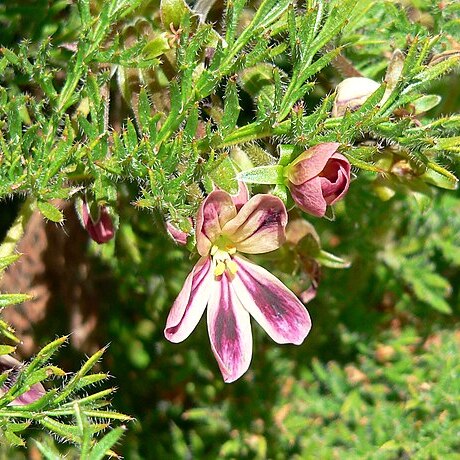A geophyte with exposed parts poorly developed, deciduous, unarmed, usually about 250 mm but occasionally up to 500 mm tall when in flower. Exposed stems rough due to stipular and petiolar scars, basally hard and woody, distally succulent, initially green but turning brown with age, up to 150 mm long and 5-10 mm thick. Leaves basal, erect to prostrate, pinnately to 4-pinnatifidly divided into linear segments usually about 1 mm wide but occasionally up to 8 mm wide in leaves with poorly differentiated segmentation, herbaceous, usually covered in a dense, short, hoary indumentum with short glandular hairs interspersed; lamina at least 2 times as long as wide, bases of segments attenuate and often petiolulate, apices of segments rounded or truncate, margins entire and involute, 100-450 x 40-150 mm; petiole up to 120 mm long, deciduous; stipules cordiform to ovate with apices acute, 5-8 x 6-10 mm, membranous becoming scarious, abaxially initially densely pubescent. Inflorescence a stout unbranched peduncle 50-250 mm long and up to 2.5 mm in diameter, carrying a pseudo-umbel of 6-15 almost regular flowers. Pedicel much shorter than hypanthium: up to 4 mm long, densely strigose and with glandular hairs. Hypanthium 30-55 mm long. Sepals narrowly ovate with apices acute, abaxially densely strigose and with sparse glandular hairs, adaxially glabrous, margins ciliate, yellow-green to dull green and occasionally russet-tinted with margins hyaline, 5-7 x 1-3 mm. Petals 5, almost equal, 10-18 mm long, uniformly pale yellow or with wine-red or purplish black markings leaving only a border of yellow, spathulate with apices rounded; posterior two 4-8 mm wide, reflexed at ±90° near base and slightly inflexed at apex; anterior three 2.5-6.0 mm wide, orientated similarly to posterior petals but less markedly reflexed. Fertile stamens 7 (4 long, 3 short and equalling staminodes), pollen bright yellow. Ovary pear-shaped, 3.5-4.5 x 2.0 mm, densely covered in apically-directed hairs, pale green; style 2.0-2.5 mm long; stigma 5-branched, reddish; mericarp base 7-10 mm long, tail 35-45 mm long. In this species flowers have been recorded practically throughout the year, but there is a marked peak from September to December.
More
Tuberous geophyte, ± 250 mm tall. Leaves prostrate, 2-or 3-pinnatisect, up to 300 mm diam., segments linear, softly hairy. Flowers in a few clusters, on a stout branched peduncle, up to 20 in each, petals 5, pale yellow or dark maroon to black with pale yellow edges, 10-18 mm long, clove-scented at night, hypanthium 25-35 mm long, much longer than pedicel.
Geophyte with large, woody tuber. Leaves prostrate, 2-or 3-pinnatisect with linear segments, softly hairy, to 30 cm diam. Flowers to 20 on a stout peduncle, 15-18 mm diam., pale yellow with dark maroon to black centres, clove-scented at night; hypanthium 25-35 mm long, much longer than pedicel.
A small herb plant. It grows 50 cm high and spreads 60-100 cm wide. It keeps growing from year to year. It forms tubers. The leaves are finely divided and carrot like. The flowers are yellow and in heads of 5-20 flowers. They are 12 mm wide.

